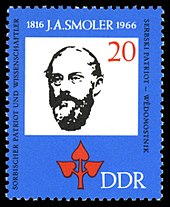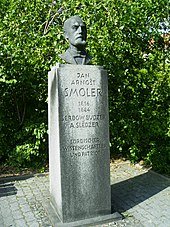Jan Arnošt Smoler
Jan Arnošt Smoler ( German Johann Ernst Schmaler ; born March 3, 1816 in Merzdorf near Uhyst , † June 13, 1884 in Bautzen ) was a Sorbian philologist , writer and publisher from Upper Lusatia . He was one of the most important representatives of the national rebirth of the Sorbs in the 19th century.
Life

Jan Arnošt Smoler's father was a Protestant cantor . In 1823 he took up a position in Lohsa , where Jan Arnošt graduated from elementary school before moving to Bautzen grammar school in 1827. Although only German was taught there, Smoler acquired extensive knowledge of his native Sorbian language in private circles during his high school years .
In 1836 he started at the University of Breslau , a study of theology . In 1839 he finished his studies and returned to his parents' house in Lohsa for almost three years. Together with Leopold Haupt and Handrij Zejler , he brought together the important Sorbian song collection “The folk songs of the Wends in Upper and Lower Lusatia” . In recognition of his services to the Wendish language, the Wendische Predigergesellschaft zu Leipzig awarded him honorary membership in 1839.
In 1847 Smoler was a co-founder of the Sorbian culture and science association Maćica Serbska . At the same time he was also politically committed to the cultural rights of the Sorbian people in the context of the 1848 revolution. The Saxon government made concessions to the Sorbs in this regard and in 1850 Sorbian lessons were introduced in some schools. In 1850 Smoler became the first Sorbian teacher at the Bautzen grammar school. He also gave lessons at the Bautzen city school. As part of this activity, he wrote several textbooks.
In the following year, Smoler founded his own publishing bookstore in Bautzen . From 1852 he published the weekly newspaper Tydźenska nowina , from which the Serbske Nowiny , which still exists today, emerged in 1854 , whose first editor and editor was also Smoler. In addition, between 1852 and 1856 he published the yearbooks for Slavic literature, art and science , which, not least of all, also achieved a high reputation among linguists abroad. From 1865 to 1868 Smoler also published the Slavic Central Gazette - a weekly for literature, art, science and national interests of all Slavs .
Smoler was one of the proponents of a cultural pan-Slavism and was a supporter of the theory of Slavic reciprocity . For his own small people in particular, he hoped that cultural contacts from the great Slavic nations would stimulate and promote the Sorbian culture in the Lusatia. Between 1859 and 1883 Smoler made several trips to Russia in order, among other things, to raise funds for the financing of his national cultural projects and the Maćica Serbska society house . In the 1870s, his son Marko Smoler (1857–1941) took over his publishing and editing activities.
Jan Arnošt Smoler died on June 13, 1884 in Bautzen . His grave is in the Protschenberg cemetery.
Post fame

In Lohsa , the legacy of Smolers and Handrij Zejler is nurtured in the meeting place Zejler-Smoler-Haus , which was established in 1994 in the former church school of the village where Smoler spent part of his childhood.
In 1991 the Domowina publishing house in Bautzen re -established the Smoler'sche publishing bookstore (Sorb. Smolerjec kniharnja) . This is the only bookstore with a full range of current Sorbian literature. There is also an extensive second-hand bookshop there .
The Bautzen regional association of Domowina bears the name "Jan Arnošt Smoler".
Works
- Wendish-German talks. Bautzen 1841
- Folk songs of the Wends in Upper and Lower Lusatia, 2nd vol. 1841 and 1843 (edited together with Leopold Haupt)
- Krotke wułpoženje powšitkomneho Serskeho prawjepisanja (Brief description of the general Wendish spelling) Bautzen 1843.
- German-Wendish dictionary. With a representation of the general Wendish spelling. Bautzen 1843
- Remains of ancient mythology in the Wendish Lausitz. [1848]
- Sorbian-Wendish language teaching. Bautzen 1850
- Short grammar of the Serbian-Wendish language in Upper Lusatia. Bautzen 1852
- The Slavic place names in Upper Lusatia and their meaning. Festschrift for the 300th anniversary of the Budissin grammar school. Bautzen 1867.
Fonts published by Smoler (selection)
- Eduard Rüffer : The Balkan Peninsula and its peoples before the solution of the oriental question: A political-ethnographic-military sketch. 1869
- P. Broniš : The Slavic family names in Niederlausitz. 1867
- Karl August Jentsch : History of the Lausitzer Predigergesellschaft zu Leipzig and a list of all its members from the years 1716–1866. 1867
- Christian Traugott Pfuhl : Phonology and form theory of the Upper Lusatian-Wendish language. With special consideration for Old Slavonic. 1867
- Carl Friedrich Robert Immisch : The Slavic place names in the Ore Mountains. 1866
- Christian Traugott Pfuhl, Handrij Zejler : Lusatian Wendish dictionary. 1866
- Slavisches Centralblatt: weekly for literature, art, science and national interests of general slavery. (Journal 1865/1866)
- Central sheet for Slavic literature and bibliography. (Journal 1867/1868)
- Journal of Slavic Literature, Art and Science
- Alexander Hilferding : Bosnia. 1858
- Alexander Hilferding: The linguistic monuments of the Drevjan and Glinjan Elbslaven in the Lüneburg Wendland. 1857
- Yearbooks for Slavic literature, art and science 1852–1856
literature
- Peter Kunze : Jan Arnošt Smoler . A life for his people. In: Writings of the Sorbian Institute Volume 10. 1st edition, Domowina-Verlag , Bautzen 1995. ISBN 3-7420-1624-5 (Sorbian: Pětr Kunze: Štóž swoju narodnosć z česću zańdźe. Nadźije a skutki Jana Arnošta Smolerja. In: Wobrazki ze Serbow . 1. nakł. Ludowe Nakł. Domowina, Budyšin 1995. ISBN 3-7420-1637-7 ).
- Peter Kunze: Smoler, Jan Arnošt. In: New German Biography (NDB). Volume 24, Duncker & Humblot, Berlin 2010, ISBN 978-3-428-11205-0 , pp. 512-514 ( digitized version ).
- Hermann Arthur Lier : Schmaler, Johann Ernst . In: Allgemeine Deutsche Biographie (ADB). Volume 31, Duncker & Humblot, Leipzig 1890, pp. 617-619.
Web links
- Literature by and about Jan Arnošt Smoler in the catalog of the German National Library
- Peter Kunze: Johann Ernst Schmaler . In: Institute for Saxon History and Folklore (Ed.): Saxon Biography .
- Meeting place Zejler-Smoler-Haus Lohsa e. V.
| personal data | |
|---|---|
| SURNAME | Smoler, Jan Arnošt |
| BRIEF DESCRIPTION | Sorbian writer and publisher (Upper Lusatia) |
| DATE OF BIRTH | March 3, 1816 |
| PLACE OF BIRTH | Merzdorf , Upper Lusatia |
| DATE OF DEATH | June 13, 1884 |
| Place of death | Bautzen |



